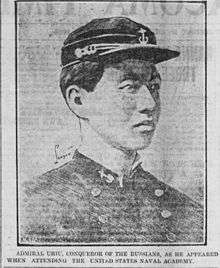Uryū Sotokichi
| Baron Uryū Sotokichi | |
|---|---|
|
Japanese Admiral Baron Uryū Sotokichi | |
| Native name | 瓜生 外吉 |
| Born |
January 2, 1857 Kanazawa, Kaga domain, Japan |
| Died |
November 11, 1937 (aged 80) [1] Tokyo, Japan |
| Allegiance |
|
| Service/branch |
|
| Years of service | 1871-1927 |
| Rank | Admiral |
| Commands held |
|
| Battles/wars | |
| Awards |
|
Baron Uryū Sotokichi (瓜生 外吉, 2 January 1857 – 11 November 1937) was an early admiral of the Imperial Japanese Navy, active in the Russo-Japanese War, most notably at the Battle of Chemulpo Bay and the Battle of Tsushima. His name has sometimes been transliterated as "Uriu Sotokichi", or "Uriu Sotokitchi", a transliteration of older kana spelling. The spelling is different by current accepted methods of transliteration, but the pronunciation is the same as the modern spelling for Uryū (うりゅう).
Biography
Born to a samurai family in the Kaga Domain (present day Kanazawa in Ishikawa prefecture), Uryū became one of the first cadets of the Imperial Japanese Naval Academy but did not graduate; instead, he was then sent to the US Naval Academy in Annapolis on 9 June 1875, returning on 2 October 1881[2]
Commissioned as a lieutenant, he served aboard various ships throughout the 1880s, including the corvette Kaimon, the ironclad Fusō, and the sloop Nisshin. On 23 July 1891, he assumed his first command: the gunboat Akagi.[2] Promoted to captain in 1891, he was then posted as naval attaché to France from 5 September 1892 to 31 August 1896.
After the outbreak of the First Sino-Japanese War, Uryū briefly commanded the new cruiser Akitsushima, followed by his old ship Fusō.
On 28 December 1897, Uryū faced a court-martial over a collision in the Seto Inland Sea in stormy weather between the cruisers Itsukushima and Matsushima, and was sentenced to prison for three months from 5 April 1898. However, this did not seem to hurt his career, as he was appointed captain of Matsushima on 1 February 1899, and the battleship Yashima on 16 June 1898. He became a rear admiral and Chief of the Imperial Japanese Navy General Staff on 21 May 1900.

Uryū was promoted to vice admiral on 6 June 1904. During the Russo-Japanese War, he commanded the Second Squadron at the Battle of Chemulpo Bay which resulted in the destruction of the Russian cruiser Varyag and gunboat Korietz.[2] For his war service, he was decorated with the Order of the Rising Sun (1st class) and the Order of the Golden Kite (2nd class) in 1906.
He was made commander of the Sasebo Naval District on 22 November 1906, he was ennobled with the title of danshaku (baron) under the kazoku peerage system on 21 September 1907.
Appointed commander of the Yokosuka Naval District on 1 December 1909, Uryū was made a full admiral on 16 October 1912. He was the official representative from Japan at the opening ceremonies for the Panama Canal in 1912. From 1922-1925, he served on the House of Peers in the Diet of Japan. He entered the reserve list in 1927, and died in 1937.
His grave is at Aoyama Cemetery in Tokyo. He was a lifelong proponent of better ties with the United States.
References
Books
- Andidora, Ronald (2000). Iron Admirals: Naval Leadership in the Twentieth Century. Greenwood Press. ISBN 0-313-31266-4.
- Dupuy, Trevor N (1992). Encyclopedia of Military Biography. I B Tauris & Co Ltd. ISBN 1-85043-569-3.
- Jukes, Geoffrey (2002). The Russo-Japanese War 1904-1905. Osprey Publishing. ISBN 978-1-84176-446-7.
- Kowner, Rotem (2006). Historical Dictionary of the Russo-Japanese War. ISBN 0-8108-4927-5: The Scarecrow Press.
| Wikimedia Commons has media related to Sotokichi Uryu. |
External links
- Nishida, Hiroshi. "Uryu Sotokichi". Imperial Japanese Navy. Retrieved 2007-08-14.
